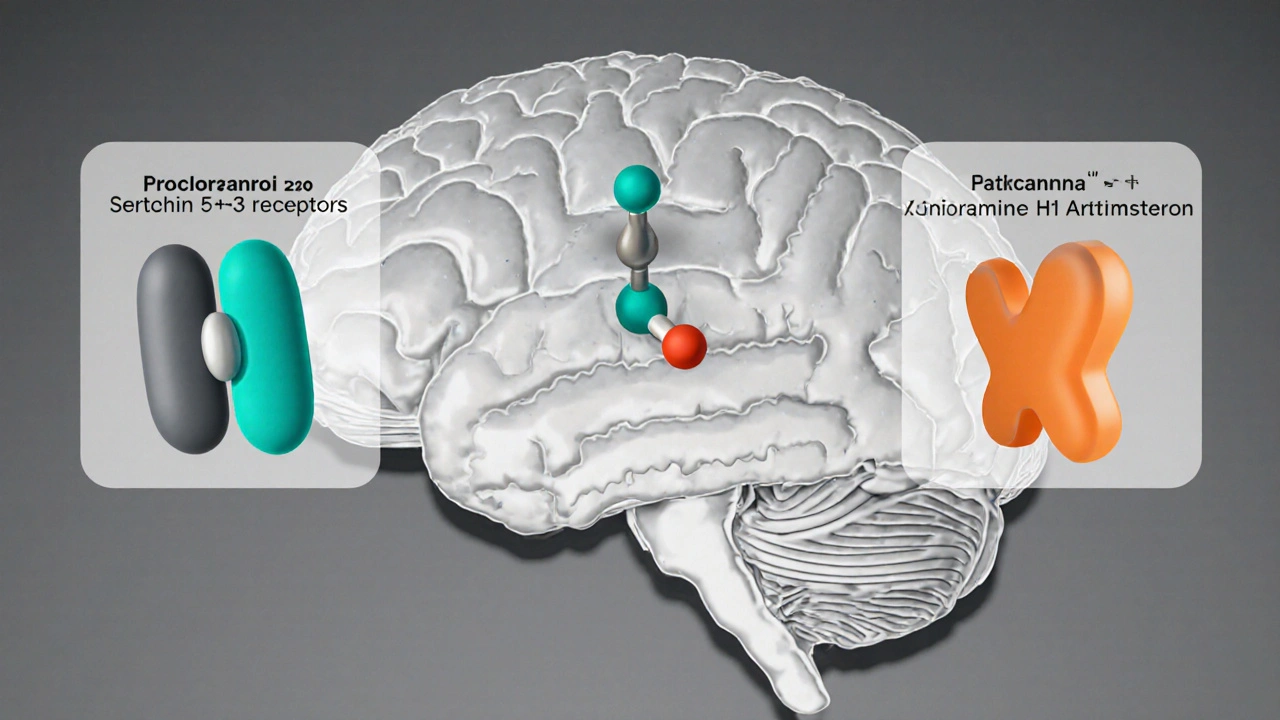Anti-Nausea Medication Decision Tool
1. What is causing your nausea?
Select the primary cause of your nausea:
2. Do you have any specific health conditions or concerns?
Select all that apply:
3. What is most important to you in a treatment?
Select your priority:
Your Recommended Options
Important considerations
Always consult with your healthcare provider before starting any new medication. This tool provides general information only and does not replace professional medical advice.
When nausea or vomiting interfere with daily life, the first question is usually “which medication will work best for me?” Compazine (prochlorperazine) is a well‑known option, but several other drugs can do the job with different benefits and drawbacks. This guide walks through how Compazine stacks up against the most common alternatives, explains when each is a good fit, and highlights key safety points you’ll want to keep in mind.
What is Compazine (Prochlorperazine)?
Compazine (Prochlorperazine) is a phenothiazine‑derived antipsychotic that also has strong anti‑emetic properties. It works by blocking dopamine D2 receptors in the chemoreceptor trigger zone of the brain, which reduces the sensation of nausea and helps stop vomiting. FDA‑approved for nausea from chemotherapy, surgery, and severe vertigo, it’s also prescribed off‑label for migraine‑related nausea and certain psychiatric conditions.
Why Look at Alternatives?
Compazine is effective, but it isn’t the only player. Some patients experience unwanted side effects, have drug interactions, or need an oral option that works faster. Knowing the landscape of alternatives helps you or your clinician tailor treatment to the specific cause of nausea, the patient’s health profile, and lifestyle preferences.
Key Alternatives and How They Differ
- Metoclopramide - a dopamine antagonist that also enhances gastrointestinal motility, making it useful for gastroparesis‑related nausea.
- Domperidone - similar to metoclopramide but does not cross the blood‑brain barrier, resulting in fewer central nervous system side effects.
- Ondansetron - a serotonin 5‑HT3 receptor antagonist, the go‑to for chemotherapy‑induced nausea and postoperative nausea.
- Promethazine - an antihistamine with anticholinergic activity, often used for motion sickness and allergy‑related nausea.
- Diphenhydramine - another antihistamine, more sedating, occasionally used for mild nausea or as a sleep aid for night‑time symptoms.
- Haloperidol - a high‑potency antipsychotic that can be repurposed for refractory nausea, especially in palliative care.
- Nausea - the symptom itself, caused by a wide range of triggers such as chemotherapy, motion, gastrointestinal disorders, and vestibular dysfunction.
Comparison Table: Efficacy, Onset, and Safety
| Medication | Primary Mechanism | Typical Onset (oral) | Effective For | Common Side Effects |
|---|---|---|---|---|
| Compazine (Prochlorperazine) | Dopamine D2 antagonism | 15-30 minutes | Chemotherapy, post‑surgical, vertigo‑related | Drowsiness, extrapyramidal symptoms, dry mouth |
| Metoclopramide | Dopamine antagonist + pro‑kinetic | 30-60 minutes | Gastroparesis, migraine‑related | Tremor, akathisia, fatigue |
| Domperidone | Peripheral dopamine antagonist | 30-45 minutes | GI motility disorders, nausea from meds | Cardiac QT prolongation (high doses) |
| Ondansetron | 5‑HT3 receptor antagonism | 10-20 minutes | Chemotherapy, postoperative, radiation | Headache, constipation, QT prolongation |
| Promethazine | Histamine H1 + anticholinergic | 20-45 minutes | Motion sickness, vertigo, allergic reactions | Strong sedation, anticholinergic load |
| Diphenhydramine | Histamine H1 antagonism | 30-60 minutes | Mild nausea, sleep aid for night‑time symptoms | Heavy sedation, dry mouth, urinary retention |
| Haloperidol | High‑potency dopamine blocker | 20-45 minutes | Refractory nausea in hospice or palliative care | Extrapyramidal symptoms, tardive dyskinesia |

When Compazine Is the Right Choice
Compazine shines in situations where dopamine blockade is the primary therapeutic goal. If nausea stems from vestibular disturbances (like vertigo) or is a side effect of dopamine‑stimulating drugs, Compazine’s mechanism directly addresses the root cause. Its relatively fast oral onset makes it a good option for breakthrough nausea in chemotherapy patients who need quick relief between cycles.
Because it’s a phenothiazine, Compazine can also help when mild psychotic symptoms or severe agitation accompany the nausea-something most antihistamines can’t manage.
Scenarios Where an Alternative Might Be Better
- Gastroparesis or delayed gastric emptying: Metoclopramide’s pro‑kinetic effect speeds stomach emptying, something Compazine does not do.
- Need for a non‑sedating option: Domperidone stays out of the brain, reducing drowsiness and extrapyramidal risk.
- High‑risk cardiac patients: Both ondansetron and domperidone can affect QT intervals, but ondansetron’s benefit‑risk profile is well‑studied for chemotherapy, while Compazine’s cardiac concerns are less prominent.
- Pregnancy: Ondansetron is often preferred for morning sickness, whereas Compazine is generally avoided unless benefits outweigh risks.
- Very mild nausea or night‑time symptoms: Diphenhydramine can double as a sleep aid, offering a two‑in‑one solution.
Side‑Effect Profile: What to Watch For
All anti‑nausea meds have trade‑offs. Compazine’s most distinctive adverse events involve the central nervous system: extrapyramidal symptoms (muscle rigidity, tremor), acute dystonia, and, rarely, tardive dyskinesia after prolonged use. These effects stem from dopamine blockade in the basal ganglia and require immediate medical attention.
Other drugs have their own flags. Metoclopramide shares similar movement disorders but adds the risk of fatigue. Domperidone’s biggest concern is cardiac QT prolongation, especially in patients with existing heart disease. Ondansetron can also prolong QT but is generally well‑tolerated. Antihistamines (promethazine, diphenhydramine) cause the most sedation, which can be useful or problematic depending on the patient’s needs.
Practical Tips for Choosing and Using Compazine
- Start with the lowest effective dose (usually 5mg orally every 6-8hours). Higher doses increase the risk of movement disorders.
- Combine with an antihistamine only if sedation is desired; otherwise, avoid adding extra sedation.
- Monitor for early signs of extrapyramidal effects-muscle stiffness, facial twitching, or restlessness. If they appear, contact a clinician promptly.
- For patients on antipsychotics or other dopamine blockers, discuss potential additive effects with a pharmacist.
- Never mix Compazine with alcohol or other CNS depressants without medical guidance.

Cost and Accessibility in 2025
Compazine is available as a generic oral tablet and an injectable form. In the United States, the generic tablet typically costs between $0.10 and $0.30 per 5mg tablet, making it an affordable option for most insurance plans. Alternatives vary: metoclopramide is similarly cheap, domperidone is not FDA‑approved (so it’s often imported and pricier), ondansetron’s oral dissolving tablets run about $1‑$2 per dose, and promethazine costs roughly $0.20‑$0.40 per tablet. Insurance coverage tends to favor generic phenothiazines and antihistamines, while newer 5‑HT3 antagonists may require prior authorization.
Bottom Line Decision Tree
Use the quick flow below to narrow down the best medication:
- Is the nausea caused by chemotherapy or severe vertigo?
Yes → Consider Compazine or Ondansetron. Choose Compazine if dopamine blockade is preferred; choose Ondansetron for proven chemo‑specific efficacy. - Is delayed gastric emptying a factor?
Yes → Metoclopramide (if CNS side effects acceptable) or Domperidone (if you need less sedation). - Is the patient pregnant or planning pregnancy?
Yes → Favor Ondansetron (after first trimester) or low‑dose Promethazine under obstetric guidance. - Is strong sedation acceptable or desired?
Yes → Promethazine or Diphenhydramine can double as sleep aid. - Are there cardiac concerns (QT prolongation)?
Yes → Avoid Domperidone and high‑dose Ondansetron; Compazine is safer for most heart patients.
Frequently Asked Questions
Frequently Asked Questions
What conditions is Compazine primarily prescribed for?
Compazine is FDA‑approved for nausea and vomiting related to chemotherapy, surgery, and severe vertigo. It’s also used off‑label for migraine‑associated nausea and certain psychiatric symptoms.
How quickly does Compazine start working?
Oral tablets usually begin to reduce nausea within 15 to 30 minutes, with peak effect at about an hour. The injectable form acts even faster, often within 5‑10 minutes.
What are the most common side effects of Compazine?
Typical side effects include drowsiness, dry mouth, and extrapyramidal symptoms such as muscle stiffness, tremor, or, rarely, tardive dyskinesia after long‑term use. If you notice any involuntary movements, seek medical help right away.
When should I consider an alternative to Compazine?
If you have a history of movement disorders, are pregnant, need a non‑sedating option, or your nausea is due to slow stomach emptying, drugs like metoclopramide, domperidone, or ondansetron may be more appropriate.
Is Compazine safe for children?
Compazine can be used in children over 2 years old for severe nausea, but dosing is weight‑based and the risk of extrapyramidal effects is higher, so clinicians often prefer ondansetron for pediatric patients.
Can I take Compazine with other medications?
Compazine interacts with other dopamine blockers, antipsychotics, and certain antidepressants, potentially increasing side‑effects. Always share a full medication list with your prescriber.
Choosing the right anti‑nausea medication boils down to matching the drug’s mechanism with the cause of nausea, while weighing side‑effect risk and patient preferences. Armed with this comparison, you can have a focused conversation with your healthcare provider and land on the option that best fits your situation.

Martin Gilmore
October 12, 2025 AT 21:51Patriots of the United States, listen up-if you think Compazine is just another pill, think again; it’s a powerhouse, a REAL American solution, beating out those foreign antihistamines with lightning speed-boom!
Abdulraheem yahya
October 13, 2025 AT 14:55When you dive into the sea of anti‑nausea options, the first wave you feel is often the sheer volume of data; the tables, the side‑effect lists, and the cost comparisons can leave anyone feeling adrift. Yet, by anchoring yourself to the core question-what triggers my nausea?-you can chart a clearer course. For instance, chemotherapy‑induced vomiting demands a rapid‑acting agent, whereas gastroparesis calls for a pro‑kinetic twist. Compazine shines bright in the former scenario because its dopamine blockade works fast, yet it may falter when you need to keep your mind sharp. On the other hand, ondansetron’s serotonin focus offers a cleaner side‑effect profile for many patients, especially those wary of extrapyramidal symptoms. Cost‑wise, generic Compazine is a bargain, but insurance formularies sometimes nudge you toward newer, pricier drugs. In the end, it’s not about the brand; it’s about matching mechanism to cause, while keeping an eye on your personal health tapestry.
Preeti Sharma
October 14, 2025 AT 07:58While most clinicians parade Compazine as the go‑to for vertigo‑related nausea, one might argue that the very act of blocking dopamine could be a double‑edged sword, subtly nudging the brain toward other imbalances. If you ponder the philosophical notion that every remedy carries its own shadow, the choice becomes less about efficacy and more about the metaphysical trade‑off. Antihistamines, for example, sedate the senses, potentially dulling the very awareness you cherish. Thus, the “best” medication is a personal confession, not a universal decree.
Ted G
October 15, 2025 AT 01:01Ever notice how the pharma lobbies whisper about “newer, safer” meds while keeping the old ones under the radar? Some say Compazine was engineered in secret labs as part of a covert program to modulate public mood. The side‑effects like extrapyramidal symptoms could be a deliberate feedback loop, a way to keep populations compliant. Remember, nothing is ever as simple as a pill.
Matt Tait
October 15, 2025 AT 18:04Honestly, if you’re still debating Compazine versus any other anti‑nausea drug, you’re overthinking a simple headache. Pick one and move on.
Benton Myers
October 16, 2025 AT 11:07Pretty solid overview, especially the part about matching the cause to the mechanism.
Keli Richards
October 17, 2025 AT 04:10Thank you for the clear comparison; the table really helped me see the differences without any unnecessary punctuation.
Ravikumar Padala
October 17, 2025 AT 21:14When I first encountered the plethora of anti‑nausea agents, I was overwhelmed by the sheer amount of clinical literature, guideline updates, and patient anecdotes that seemed to swirl around me like a nauseating vortex, each promising a miracle cure; yet, as I delved deeper into the pharmacodynamics, a pattern emerged, revealing that most of these medications target either the dopamine pathways, the serotonin receptors, or the histamine channels, each with its own set of trade‑offs and side‑effect spectrums. The dopamine antagonists, such as Compazine, offer rapid relief and are particularly effective in scenarios where the chemoreceptor trigger zone is hyperactive, but they carry the risk of extrapyramidal symptoms, which can be distressing for patients who are already coping with other ailments. Serotonin 5‑HT3 antagonists like ondansetron, on the other hand, provide a cleaner side‑effect profile for many, yet they can prolong the QT interval, a concern for those with underlying cardiac issues. Antihistamines, exemplified by promethazine and diphenhydramine, introduce potent sedation, which some patients find beneficial as a dual sleep‑aid, but this very sedation can impair daily functioning if taken during daytime. Moreover, the pro‑kinetic agents such as metoclopramide address the underlying motility problem in gastroparesis, effectively reducing nausea at its source, yet they also share the dopamine antagonist’s risk of movement disorders. When I mapped these mechanisms onto a decision tree, the reality became evident: the “best” choice is highly contextual, hinging on the etiology of nausea, patient comorbidities, and personal preferences regarding side‑effects. For a chemotherapy patient who cannot tolerate sedation, a serotonin antagonist might be more suitable, whereas a postoperative patient seeking quick, cost‑effective relief might gravitate toward Compazine. Additionally, the economic factor cannot be ignored; generic versions of many of these drugs remain affordable, but insurance formularies sometimes dictate otherwise, compelling a switch to newer, more expensive options. Ultimately, the clinician’s role is to synthesize this complex data, ask targeted questions about the patient’s medical history, and then prescribe a medication that aligns with both clinical efficacy and the individual’s lifestyle. In my experience, transparent communication about potential side‑effects empowers patients, making adherence more likely, and reduces the anxiety that often accompanies new medication regimens. So, while the tables and charts provide a foundation, the art of medicine lies in customizing treatment to the unique tapestry of each patient’s condition and circumstances.
King Shayne I
October 18, 2025 AT 14:17I see your point, but I think the balance is more complex than you think.
jennifer jackson
October 19, 2025 AT 07:20Keep shining-you’ve got this!
Brenda Martinez
October 20, 2025 AT 00:23Let’s get real: the “secret labs” narrative is just a distraction from the real data showing Compazine’s efficacy; the studies are transparent, peer‑reviewed, and repeatedly demonstrate its rapid onset, making it a legitimate choice for many patients, despite the occasional myth.
Marlene Schanz
October 20, 2025 AT 17:26Hey there, just a quick heads‑up: if you’re dealing with delayed stomach emptying, metoclopramide might actually help more than Compazine because it pushes the stomach along, not just blocks the nausea signal.
Eric Sevigny
October 21, 2025 AT 10:29From a clinical standpoint, always check the patient’s QT interval before starting ondansetron or any meds that can affect the heart; it’s a simple EKG that can prevent serious complications.
Glenda Rosa
October 22, 2025 AT 03:32Oh, the drama! While you dismiss the debate, many patients swear by the nuanced differences between dopamine blockers and serotonin antagonists, arguing that the “quick fix” approach overlooks long‑term quality of life-so yeah, maybe there’s more to discuss.
David Stephen
October 22, 2025 AT 20:36Remember, every patient’s journey is unique; guide them through the options, listen actively, and empower them to make an informed decision that fits their life.
John Blas
October 23, 2025 AT 13:39Wow, another boring rundown-could’ve been shorter.
Matthew Marshall
October 24, 2025 AT 06:42The truth? No pill is a miracle, but Compazine sure does the heavy lifting when you need it.
Lexi Benson
October 24, 2025 AT 23:45Oh, great, another rose‑tinted pep talk-because we all know optimism cures nausea, right?
Vera REA
October 25, 2025 AT 16:48From a cultural perspective, it’s interesting how different regions prefer certain anti‑nausea agents, reflecting local prescribing habits and patient expectations.
John Moore
October 26, 2025 AT 09:51Let’s focus on collaboration-sharing experiences with these medications helps everyone find the right fit without judgment.